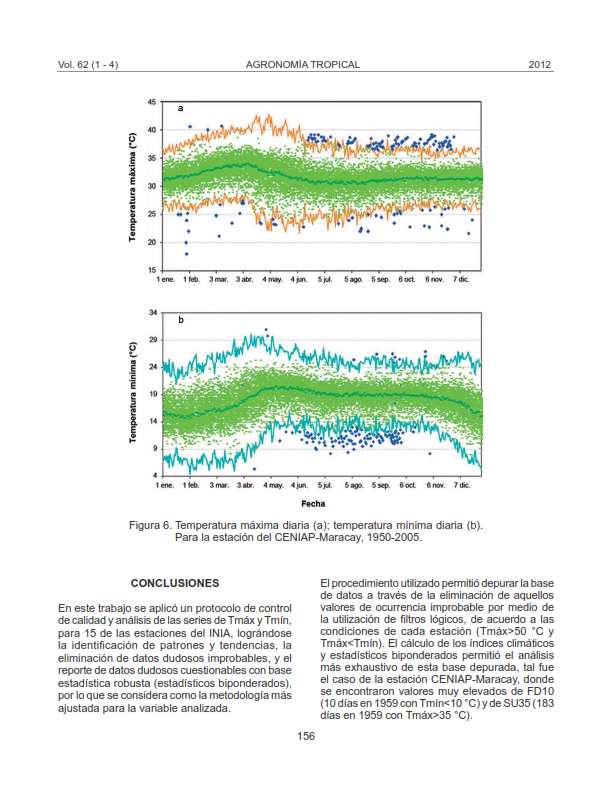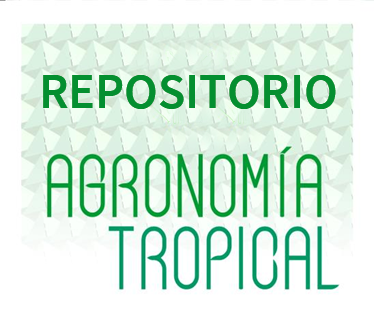Quality control of the series of daily temperature for the stations of the INIA-Venezuela in the period 1950-2005
Abstract
The data quality control as an initial phase in any study that involves calculation, it is a vital step that ensures the accuracy of the results and interpretations of them. The most notable problem with the quality control of climate data is the presence of outliers due that, removing them or keep them can affect the analysis of events leading to overestimates or underestimates. In the present work was implemented a methodology for quality control of temperature data through the integration of various analysis that includes the identification of outliers with robust statistical measures in 15 climatic stations of INIA. It was found that the majority of the comments fell dawn within the expected thresholds. In the analysis of the temporal series, some cases were detected with Tmax>50 and Tmax °C<Tmin (OTD< 0 °C), which were eliminated. In the station CENIAP-Maracay it was found very high values of FD10 (10 days in 1959 with Tmin< 10 °C) and SU35 (183 days in 1959 with Tmax>35 °C). It was demonstrated that through the construction of intervals with mean and deviation bi-weighted, it is possible to detect series with questionable data, as the temperature serie may-november/1959 of CENIAP-Maracay where Tmax> than the upper limit and Tmin<than the lower limit. The questioned values were reported in the refined data base.
Downloads
References
• Feng, S., Q. Hu. and W. Qian. 2004. Quality control of daily meteorological data in China, 1951-2000: A new dataset. Int. J. Climatol. 24(1):853-870.
• Lanzante, J. 1996. Resistant, robust, and nonparametric techniques for the analysis of climate data. Theory and examples, including applications to historical radiosonde station data. Int. J Climatol. 16(3):1.197-1.226.
• Lobo, D., D. Gabrield, F. Ovalles, F. Santibañez, M.C. Moyano, R. Aguilera, R. Pizarro, C. Sanguesa y U. Nelson. 2005. Guía metodológica para la elaboración del mapa de zonas áridas, semiáridas y subhúmedas secas de América Latina y el Caribe. CAZALAC, Chile. 59 p.
• Ministerio del Ambiente y Recursos Naturales (MARN). 2005. Primera Comunicación Nacional en Cambio Climático de Venezuela. MARN, Programa de las Naciones Unidas para el Desarrollo, Fondo Mundial para el Medio Ambiente. Venezuela. 164 p.
• National Climatic Data Center. 2002. Data docu- mentation for Data Set 9300 (DSI-9300) Global Historical Climatology Network – Daily v. 1.0. Ashville, USA. 17 p.
• Rodríguez, M. F., A. Cortez, J. C. Rey, M. C. Núñez, F. Ovalles y R. Parra. 2011. Integración espacial y aplicación de los datos agroecológicos del INIA al Norte del Orinoco de Venezuela. Proyecto financiado por el FONACIT S1-20022000417. Instituto Nacional de Investigaciones Agrícolas (INIA.) 371 p.
• Shaw, E. 1988. Hydrology in Practice. 2a edición. Chapman & Hall, Londres-UK. 539 p.
• Vincent, L. A., T. C. Peterson, V. R. Barros, M. B. Marino, M. Rusticucci, G. Carrasco, E. Ramírez, L. M. Alves, T. Amvrizzi, M. A. Berlato, A. M. Grimm, J. A. Marengo, L. Molion, D. F. Moncunill, E. Rebello, Y. M. T. Anuncisção, J. Quintana, J. L. Santos, J. Báez, G. Coronel, J. García, I. Trebejo, M. Bidegain, M. R. Haylock and D. Karoly. 2005. Observed Trends in Indices of Daily Temperature Extremes in South America 1960-2000. Journal of Climate. 18(23):5.011-5.023.
• Wulfmeyer, V. and I. Henning-Müller. 2005. The climate station of the University of Hohenheim: Analyses of air temperature and precipi- tation time series since 1878. Int. J. Climatol. 26(1):113-138.





